|
This is not a Honda V4. It is, however, a Honda, it is a V, and it is tarted up to to look like one of the most iconic and beautiful bikes ever to grace the world's roads, the VFR750R, aka RC30. This is, in fact, the RC31, known in the U.S. as the NT650 or Hawk GT, a 647cc V-twin sport bike available in 1988-91. It was ahead of its time as a naked sport bike in an era of plastic-wrapped race replicas. The Hawk sported some cool stuff like aluminum box frame and single-sided swingarm, and the bike weighed in at just over 400 pounds. I'm pretty sure the later Ducati Monster took some, ah, inspiration from the styling (from the stock bike, not this example). The little GT was a blast to ride, to which I can personally attest, as I had a gorgeous red one back in 2002. Unfortunately, I found the bike a bit small for my growing frame, otherwise it would still be here today. Today's bike comes to us from Iconic Motorbike Auctions. This bike was built back in 1990 by Two Brothers Racing as a race bike, competing against (and beating) bigger Ducatis. The engine is a Stage 1 J.D. Hord-built 700cc motor that features cams, a ported head, lightened pistons, and Two Bro's carb kit — it’s been dyno’d at almost 70 rear-wheel HP. Less than 500 miles are on the motor at most. The bike weighs just over 300 pounds and sports an RC30 front end and rare Two Brothers RC30 body kit. It's sporting a license plate so must be street legal, but that's probably not the point for its next owner. Pretty cool. And here's a shot of my Hawk........
0 Comments
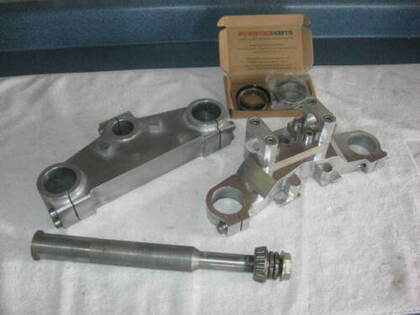 Click on image for the eBay link. Click on image for the eBay link. From seller edinburough in Ontario, Canada we have an eclectic collection of VFR bits up for auction with Buy-It-Now prices provided. For the upgraded forks crowd, here's a complete billet steering stem setup for 41mm forks. The seller refers to these as replicas of the HRC parts from the VFR racing glory days. Adaptable to clip-ons or handlebars. These appear to be used items, but the seller doesn't specify. The auction begins at $601 (USD) or $864 Buy-It-Now plus unspecified shipping costs (the seller cautions that his shipping costs are kinda high). I don't profess to know the value of something like this, but that looks like a chuck of money to me. Clicking on "See Other Items" in the listing, we find that our seller has several more 2d-gen items listed, also at premium prices...a nice-looking set of side fairings (BIN $244+), an average seat cowl ($244+), a set of turn signals ($83+) and a set of NOS brake/shift pedals ($150+) plus a few additional items...... 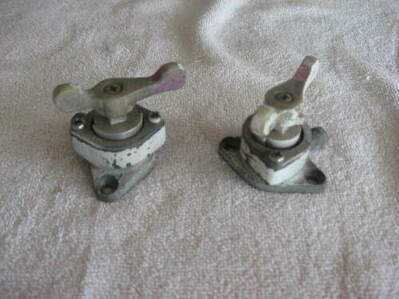 .....like this set of petcocks listed as "Joey Dunlop RVF magnesium petcock set" from HRC. I have no idea how these would be authenticated, but they can be yours for $526+. Project 11 is in the reassembly stage, but along the way I decided to up its game.... 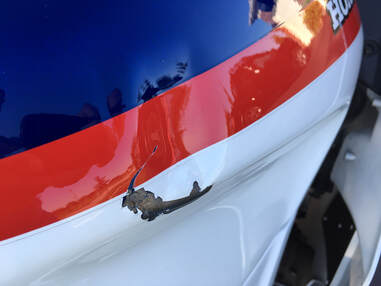 The biggest challenge I faced with this bike was an impressive 3-inch dent on the right side of the fuel tank. The rest of the bodywork on this 1986 VFR700 is in very nice original condition, so I really wanted to save the existing tank as opposed to a full repaint. I began with my paintless dent expert who was able to get the metal back to about 90%, with most of the remaining blemish in the white area of this dent. There still remained chipped white paint and some surface unevenness. 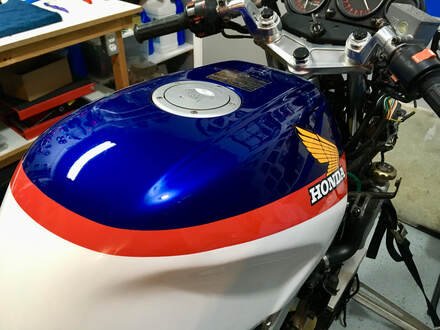 My next stop was a visit with Bill, my painter. This was a tricky fix. We needed to attack only the white (the red is actually a decal) so to accomplish filler, sanding and paint adjacent to the red stripe wouldn't be a simple task. During the work, some original clearcoat began to separate on a section of the red, so that would need to be addressed as well. In the end, Bill really come through. There's still some imperfection due to a scratch on the red stripe, but the white was blended perfectly and the final clearcoat brought it all together. Most importantly, the original fuel tank was rescued. 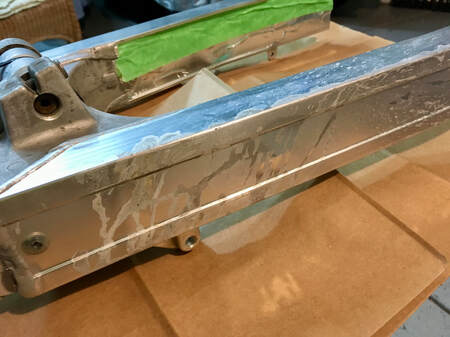 Next up was the defaced swingarm, where a liquid, most likely battery acid, had stripped the anodizing from the metal and left this ugly mess (right). 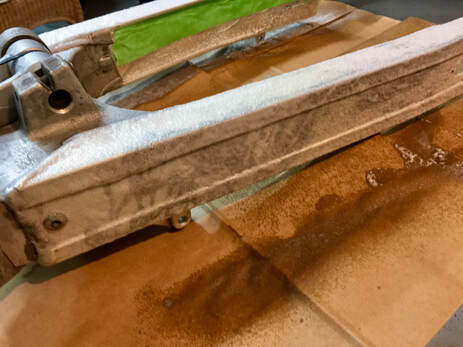 I discovered the fix a couple of years ago, which requires removal of the anodizing using oven cleaner, a very caustic foaming agent. I apply a first coat, let it set 20 minutes, wipe clean, and then apply a second coat for about 10 minutes to clean up any remaining spots. This is followed by wet-sanding, in this case beginning with a relatively rough 220-grit (to sand down through the damaged aluminum) and working my way up to 800-grit. The final step is hand polishing with aluminum polish to whatever level of shine I'm happy with. Looks much better. (click on an image to enlarge) 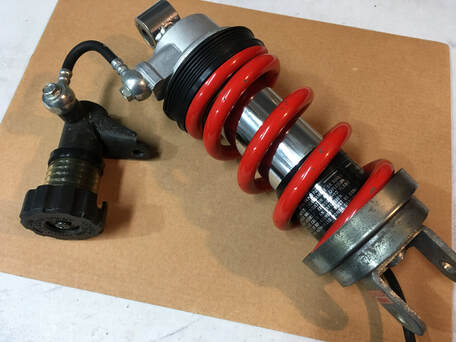 With the swingarm out of the way, I took the opportunity to remove the shock absorber for a detailing. 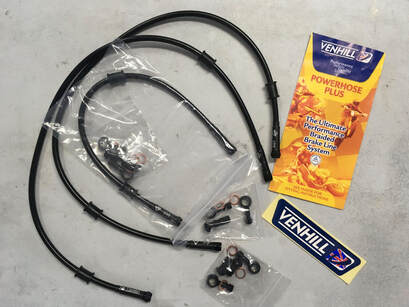 Next up is a brake line upgrade. I've always used Galfer brand stainless steel lines in the past, but decided to try a set of Venhill "Powerhouse Plus" lines in black. 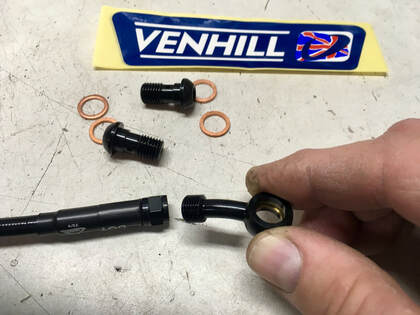 Venhill is a UK-based manufacturer and have been doing this for 45 years. They take a little different approach to the lines themselves by separating the end fittings, whereas Galfer, for example, furnishes the lines as a complete assembly. Not sure why, but maybe helps keep the cost down a bit. The price was $98 (front & rear) plus $17 shipping for a total of $115. I ordered through an eBay seller called Up The Shop. The lines can be ordered in different colors and length-specific, if you wish, at no additional charge. Shipping took about ten days. These lines have a high quality look and feel to them, installed easily and the black color helps preserve the original look of the bike. What else? Well, the carburetors have been treated to modern seals, cleaned and sync'd, along with fresh fuel lines and filter. The fork has been flushed, steering bearings installed, an OEM rear fender extension refitted, brake calipers cleaned, inspected and assembled and a full set of OEM turn signals have been restored, mounted with new, shorter stems. I'm also in the process of doing repairs to the headlight fairing in order to hide four small holes used to mount aftermarket turn signals, but that's a separate post.
This project began as a very nice Interceptor and is only getting better. 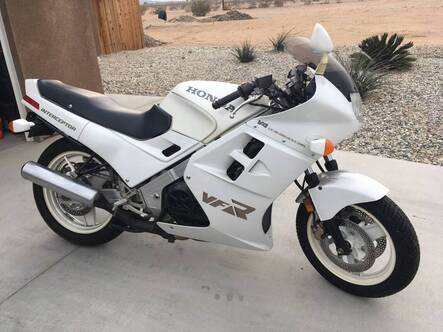 Click on image for the Cycle Trader link. Click on image for the Cycle Trader link. What: 1987 VFR700 F2 Where: Ridgecrest, California Why: Original, low miles Price: $4200 For the 1987 model year, Honda offered only the 700cc "tariff beater" VFR in the U.S. market. Some running changes were made to the 700s during the '86 model year and these were officially known as the F2, available in "limited quantities" in Pearl Crescent White, which became a standard color option for 1987. Today we have this very complete and original-condition F2 showing only 7450 miles. The seller indicates that he acquired this bike from the original owner, also in southern California, and after bringing the mechanicals up-to-date, has doubled the mileage over the past year. The bike is showing a bit of sun damage from its life in the California desert and the lower part of the fuel tank seems to be a few shades off paintwise, but that could just be the photo. One of the pics shows the rear seat cowl in place and a service manual and OEM tool kit are also included. The seller's price of $4200 reflects the low miles and originality, though I'd want to see more detailed photos, particularly of the mufflers and any possible cosmetic flaws. Unmolested, original second-gen VFRs are becoming fewer and farther, so here's a chance at what looks to be a nice one. 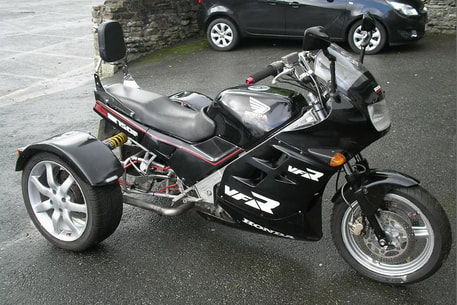 A few weeks back I posted about the horrible concept of an Interceptor trike conversion. Here's another example from the RC24/26 Facebook page. So I guess it's a thing...but I still don't get it. That exhaust appears to be unmuffled, so the sound must be, ah, impressive. But it's the mirrors that take today's design award. 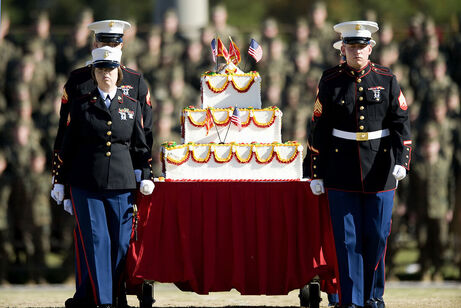 The Continental Marines were established on this day in 1775, and today myself and all former Marines note the Corps birthday. Part of the pageantry includes a formal ball with cake cutting ceremony, where the first piece cut is presented to the oldest Marine present and he/she then hands it to the youngest, symbolizing passing of knowledge and tradition to the new generation. Semper Fidelis, guys. 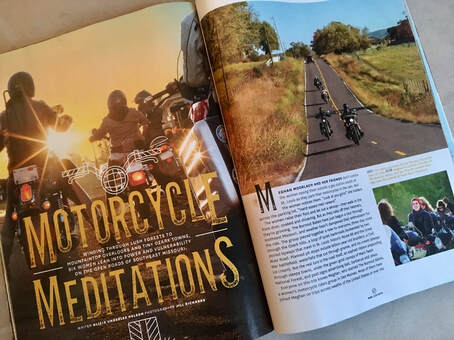 Sitting in my dentist's waiting room a few days ago, I happened to pick up the Sept/Oct issue of Midwest Living and found this feature article. It's written by Alicia Underlee Nelson, and it's about a group of women riders loosely based in the upper midwest, who put together their own version of interesting rides. In this case they're riding a 300-mile loop to the southwest of St. Louis, but what really caught my attention is the writer's comment on an aspect of our sport we don't talk much about — danger. Our daughter-in-law once commented that Patti & I take part in two recreational activities which reside near the top of the "most dangerous" list; motorcycling and horseback riding. I checked, turns out she's done her homework. We definitely don't see ourselves as daredevil adventurers, quite the opposite, as it seems to me that things like base jumping and rock climbing have more pain potential, but apparently not. The author writes: "...the shadow side of a motorcycle's power is vulnerability — to the elements, to road conditions, to rider fatigue, to other drivers. On or off the road, the fragility of life always hangs close, unspoken but respected." I've been riding for 48 years and learned on my own. I had two rookie single-vehicle bike crashes in my first year and none since, plus my share of close calls, mostly from other drivers. Motorcycle crash statistics are sobering, but a little sticky — they can be manipulated like any statistic. But here's a relevant sample: Motorcyclists in Colorado make up only 1% of miles traveled, but are 16.3% of the fatalities, and 75% of those were the rider's fault (Motorcycle Consumer News). The majority of bike crashes are single-vehicle and most are the result of simply running off the road. When another vehicle is involved, it's most likely an approaching car turning left in front of a bike. Somewhere around 50% of fatal crashes involve alcohol. And this: Most crash testing is done at 30mph and helmet certification is performed at only 24mph. Above those parameters and you've become your own crash test dummy. You'll note that the word "accident" isn't used here. That's because insurers don't consider crashes to be accidental. There's always one or more contributing factors that might have been mitigated by those involved. In aviation, we learn to recognize and mitigate those factors the best we can, and there's a lesson there. The old saying, "there's old pilots and there's bold pilots, but there's no old, bold pilots" is a pithy way of saying that taking riding seriously should involve regular training, constant awareness and riding sober. All the things you've heard about motorcycle safety apply — speed is fun, but speed kills more effectively, riding above your or your bike's abilities, riding in bad weather, riding at night, riding with no protection, falsely assuming other drivers see you, and so forth. Whenever someone asks me about taking up the sport, I find myself instinctively discouraging it. When they ask why, I almost always blurt out, "because it's dangerous." I know that I shouldn't discourage new riders, but I think of all the years of experience that help keep me (hopefully) safe on a motorcycle and cringe at the vulnerability of a new rider out in the real world after nothing more than some cursory classroom and parking lot training, especially if it involves a loved one. And that's too bad. We all ride for our own reasons, every time we do we accept the risks that we know lurk in the shadows of our sport. As Orville Wright noted, "Carelessness and overconfidence are usually more dangerous than deliberately accepted risks." ...and then there's these guys.......... (skip to 1:15) 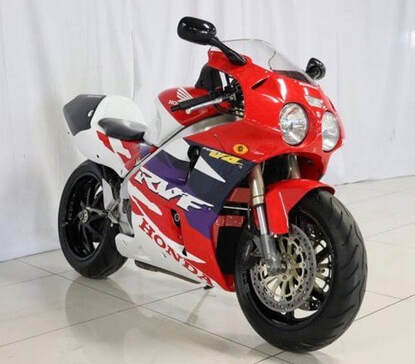 Click on image for the RSBFS link. Click on image for the RSBFS link. What: 1994 RVF750RR (RC45) Where: South Africa Why: Rare, rideable, "Euro power" Price: $35,000 includes worldwide shipping Here's a fairly rare opportunity to acquire a genuine factory homologation bike, produced from 1994-99. The U.S. got this model only in '94, a neutered version powered down to 105 HP. This "Euro" version put out a bit more, 118, and this one sports a sexy Yoshimura exhaust. And, you might not feel bad actually riding this RVF, as it's already covered 21,250 miles. Available as a featured listing on RareSportBikesForSale.com. Click on image for a very nice write-up on the RC45. |
THE SHOP BLOG
|
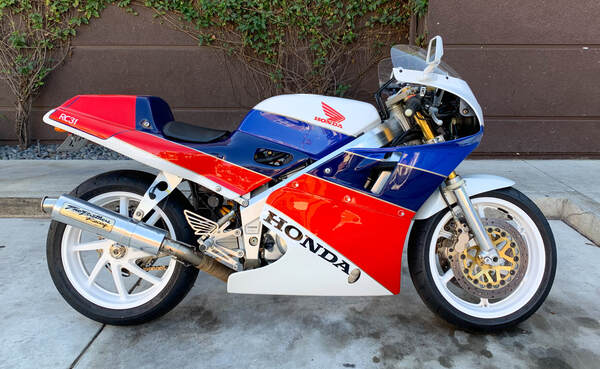




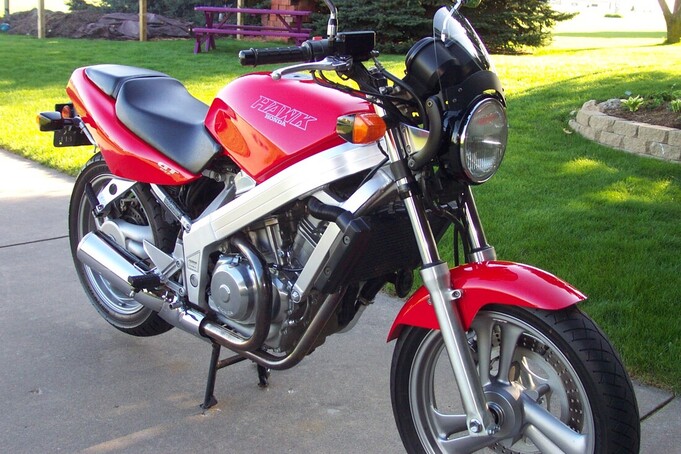




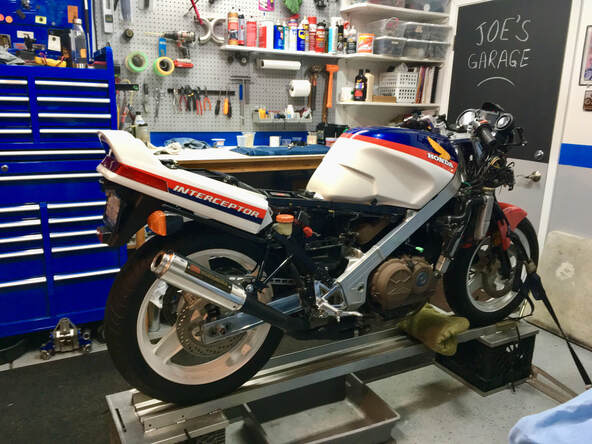









 RSS Feed
RSS Feed